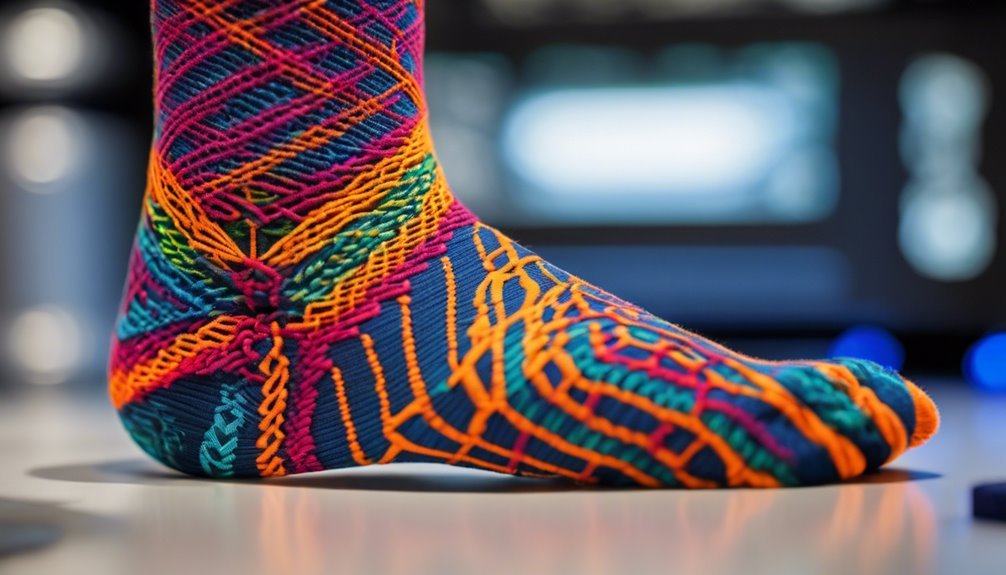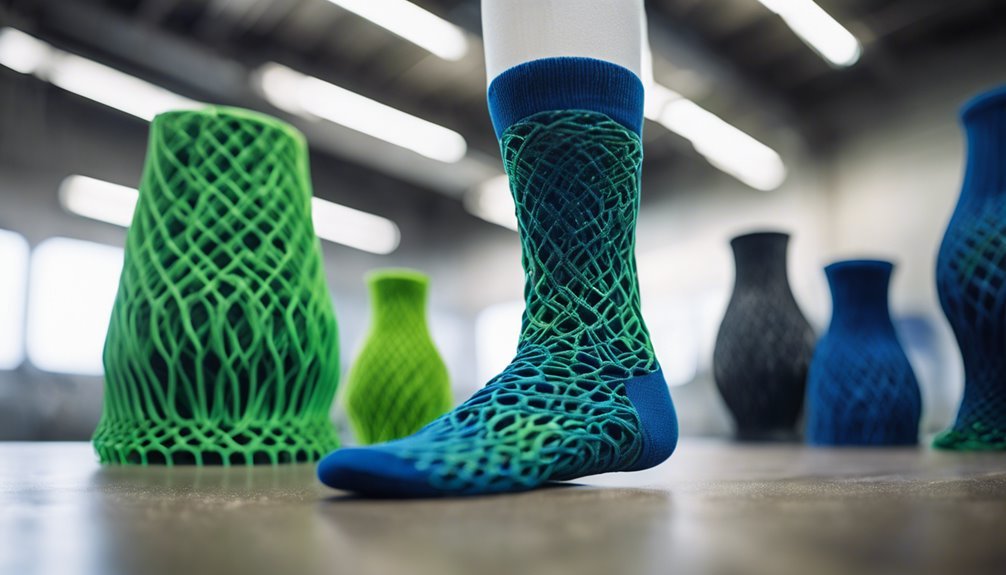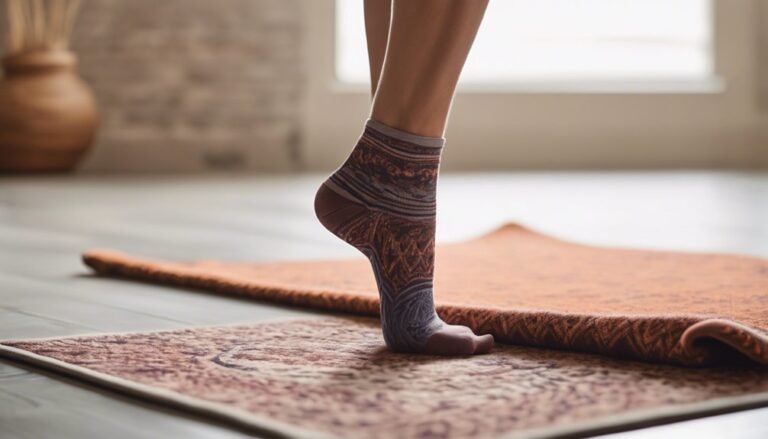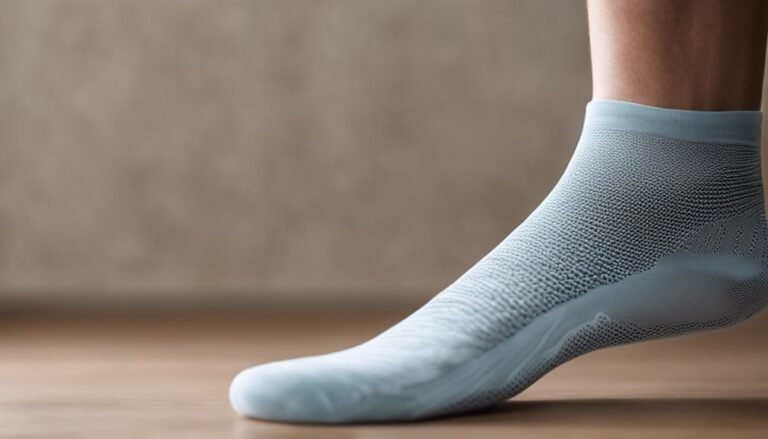How AI & 3D Printing Are Revolutionizing Sock Manufacturing
AI and 3D printing are reshaping sock manufacturing by streamlining design and production. AI analyzes trends and consumer feedback for optimized designs, while 3D printing allows for unique, personalized fits that cater to individual style. These technologies enhance operational efficiency and sustainability by minimizing waste and utilizing eco-friendly materials. With predictive analytics, brands can swiftly adapt to market demands, creating a competitive edge. Discover how these innovations continue to evolve the industry further.
The Role of AI in Sock Design Optimization

As the demand for personalized and high-quality socks continues to rise, AI plays a pivotal role in optimizing sock design. By leveraging data analytics, AI can identify trends in sock aesthetics, tailoring designs to align with consumer preferences. Algorithmic patterns generated through machine learning enable designers to experiment with various styles and materials efficiently. This data-driven approach allows for rapid iterations, ensuring that your socks stand out in a competitive market. Additionally, AI can predict future trends, helping brands stay ahead of the curve. By incorporating consumer feedback and market insights, you can create socks that not only meet but exceed expectations, offering a unique blend of comfort and style that resonates with your desire for freedom in self-expression.
Customization: 3D Printing for Personalized Socks
While the traditional sock manufacturing process often limits personalization, 3D printing revolutionizes the way you can customize your socks. This technology enables you to create personalized patterns that reflect your individual style, breaking free from the constraints of mass production. Imagine designing socks that not only look unique but also provide unique fits tailored to your foot's shape. Data shows that consumers are increasingly seeking products that resonate with their personal identity, and 3D printing meets this demand by offering an unprecedented level of customization. With this innovation, you can express your creativity while ensuring comfort, resulting in a product that feels genuinely yours. Embracing 3D-printed socks means embracing a future where individuality reigns supreme.
Streamlining Production Processes With AI
Building on the foundation of customization, AI is transforming how sock manufacturers streamline production processes. By utilizing predictive analytics, companies can forecast demand with impressive accuracy, enabling them to optimize inventory levels and reduce lead times. This data-driven approach not only enhances efficiency but also greatly cuts costs. Automated quality checks powered by AI algorithms guarantee that each pair of socks meets stringent standards, reducing the risk of defects. As you embrace these innovations, you'll find that production becomes more agile, allowing for rapid adjustments to changing market demands. In this landscape, AI not only amplifies operational efficiency but also empowers manufacturers to focus on creativity and sustainability, ultimately enhancing your freedom to innovate in a competitive market.
Reducing Waste Through Innovative Manufacturing Techniques

In sock manufacturing, reducing waste hinges on sustainable material choices and precision production processes. By selecting eco-friendly materials, you not only minimize environmental impact but also enhance product lifecycle. Coupled with advanced manufacturing techniques, this approach greatly cuts down on excess waste, leading to a more efficient and responsible production model.
Sustainable Material Choices
How can the integration of AI and 3D printing reshape sustainable material choices in sock manufacturing? By leveraging smart technologies, manufacturers can prioritize biodegradable fibers and recycled materials, minimizing environmental impact. Here's a breakdown of how these materials contribute to sustainability:
| Material Type | Benefits | Impact on Waste |
|---|---|---|
| Biodegradable Fibers | Decomposes naturally | Reduces landfill bulk |
| Recycled Materials | Utilizes post-consumer waste | Lowers resource demand |
| Organic Cotton | Chemical-free production | Supports eco-farming |
| Hemp | Grows with minimal water | Enhances soil health |
Implementing these choices not only leads to a greener product but also encourages a culture of sustainable consumerism, allowing you to make informed decisions that align with your values.
Precision Production Processes
While traditional sock manufacturing often results in considerable material waste, the advent of AI and 3D printing technologies offers a transformative approach to precision production processes. Automated knitting systems enable you to create socks with intricate designs while minimizing fabric waste. By utilizing these technologies, manufacturers can produce only what's needed, markedly reducing overproduction. Additionally, AI-driven quality assurance processes guarantee that each sock meets high standards, detecting defects in real-time. This level of efficiency not only conserves resources but also enhances product quality, providing you with a superior final product. Ultimately, embracing these innovative manufacturing techniques empowers both producers and consumers, fostering a more sustainable and waste-conscious industry.
Sustainability Initiatives in Sock Production

As manufacturers increasingly recognize the environmental impact of their operations, sustainability initiatives in sock production have gained significant traction. The shift towards eco-friendly practices not only conserves resources but also appeals to conscious consumers. Here's a snapshot of some key initiatives:
| Initiative | Description | Impact |
|---|---|---|
| Recycled Materials | Use of post-consumer plastics and textiles | Reduces waste |
| Eco-Friendly Dyes | Natural dyes that minimize water pollution | Lowers environmental footprint |
| Energy Efficiency | Adoption of renewable energy sources | Cuts carbon emissions |
| Water Conservation | Closed-loop systems in production | Saves water |
| Packaging Reduction | Minimalist packaging solutions | Decreases waste |
These strategies not only enhance brand loyalty but also pave the way for a more sustainable future.
Enhancing Consumer Experience With Technology
In today's competitive market, leveraging technology to enhance consumer experience has become essential for sock manufacturers aiming to differentiate themselves. By adopting AI and 3D printing, brands can create a more personalized shopping journey that resonates with your needs. Here are three ways technology is transforming your sock experience:
- Smart Shopping: AI-driven recommendations analyze your preferences, ensuring you find the perfect pair with ease.
- Interactive Fitting: Virtual fitting rooms allow you to see how different styles and sizes look on your feet, minimizing the hassle of returns.
- Customization Options: Design tools enable you to create unique socks that reflect your personality and style.
These innovations not only streamline your shopping experience but also empower you to make informed choices, enhancing overall satisfaction.
Frequently Asked Questions
How Much Do 3d-Printed Socks Typically Cost?
3D-printed socks typically range from $15 to $50, depending on materials and technology. While initial production costs may be higher, their sustainability impact can lead to long-term savings and reduced environmental footprint, appealing to conscious consumers like you.
Can AI Predict Future Sock Trends Effectively?
Yes, AI can effectively predict future sock trends by analyzing trend data and consumer preferences. Its ability to process vast datasets allows for insightful projections, helping you stay ahead in a rapidly evolving market.
What Materials Are Commonly Used in 3D Sock Printing?
When it comes to 3D sock printing, you'll often find nylon blends and flexible filaments being used. These materials provide durability and comfort, allowing for innovative designs that cater to your desire for freedom and expression.
Are There Any Health Benefits to Custom-Fit Socks?
Custom-fit socks provide significant health benefits by enhancing foot comfort and support. They reduce friction and pressure points, promoting better circulation and preventing common foot issues, ultimately contributing to overall foot health and your freedom of movement.
How Long Does It Take to Produce 3d-Printed Socks?
Producing 3D-printed socks typically takes a few hours, thanks to advancements in production speed and manufacturing efficiency. This rapid turnaround allows you to quickly enjoy custom designs tailored to your unique preferences and needs.







